In this blog post, I will show you the steps to disable context menu in Start menu using Intune. A context menu appears when you right-click on any icon in the Start menu on Windows 10/11 devices, providing you with a list of quick actions you can take.
Below screenshot shows an example where I right-clicked on the Bitwarden application icon in the Start menu and accessed the context menu. It displays options such as Pin to Start, Run as administrator, Pin to taskbar, or even Uninstall this app, provided you have the appropriate rights.
If you do not want to display the context menu to users when they right-click on a Start menu Icon, you can easily disable it using Intune via a setting catalog policy setting called Disable Context Menus.
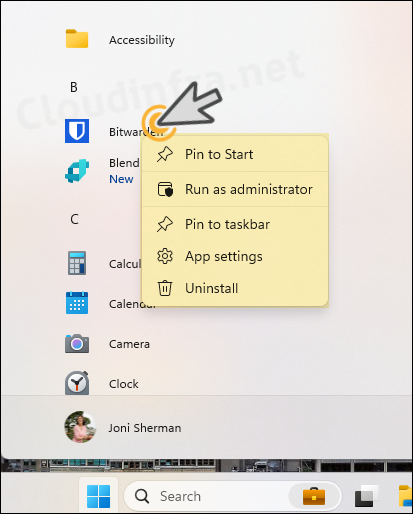
Contents
Disable Right-Click Context Menu Intune Policy
Let’s create an Intune policy to disable right-click context menu in Start menu on Windows 10 and Windows 11 devices.
- Sign in to Intune admin center > Devices > Windows > Configuration > Create > New Policy.
- Platform: Windows 10 and later
- Profile type: Settings catalog
- Click Create.
- On the Basics tab, provide a Name and Description of the policy and click Next.
- On Configuration settings tab, click on + Add settings and use the Settings picker to search using Disable Context keyword and select Start category. Check the policy, Disable Context Menus.
Please note that you can also use Disable Context Menus (User) policy to disable the Context menu per user. This is a user based setting, therefore, you can assign this to Entra security group containing users. If you use Disable Context Menus, which is what we are using, It applies at the device level which affects all users using that device.
Disable Context Menus (User)
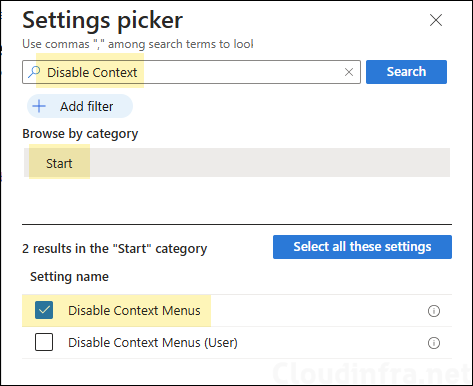
- Use the toggle switch next to Disable Context Menus and set it to Enabled.
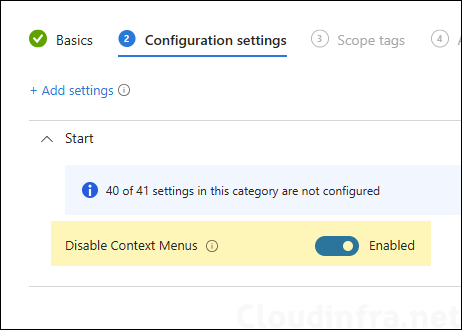
- Scope tags (optional): A scope tag in Intune is an RBAC label you add to resources (policies, apps, devices) to limit which admins can see and manage them. For more Information, read: How to use Scope tags in Intune.
- Assignments: Assign the policy to Entra security groups that contain the target users or devices. As a best practice, pilot with a small set first; once validated, roll it out more broadly. For guidance on assignment strategy, see Intune assignments: User groups vs. Device groups.
- Review + create: Review the deployment summary and click Create.
Monitoring Disable Context Menu Policy Deployment
- Sign in to the Intune admin center > Devices > Configuration.
- Choose the Device Configuration profile you want to work with, and at the top of the page, you’ll see a quick view of the Success, Failure, Conflict, Not Applicable, and In Progress status.
- Click on View report to access more detailed information.
Sync Intune Policies
The device check-in process might not begin immediately. If you’re testing this policy on a test device, you can manually kickstart Intune sync from the device itself or remotely through the Intune admin center.
Alternatively, you can use PowerShell to force the Intune sync on Windows devices. Restarting the device is another way to trigger the Intune device check-in process.
End User Experience
After the deployment is completed successfully, sign in to one of the target devices and check if you can access the context menu when you right-click on any icon in the Start menu. During my testing, I found that pinned apps were still displaying the context menu when I right-clicked on them (as shown in the left-hand side screenshot).
Click on All, then right-click on any icon. You will notice that the context menu is disabled, and nothing happens when you right-click. This confirms that the Intune policy has been successfully applied to the device. You can compare the right-hand side screenshot with the one provided at the beginning of this post, which shows the context menu being displayed when right-clicking on an icon in the Start menu. Now, the context menu does not appear.
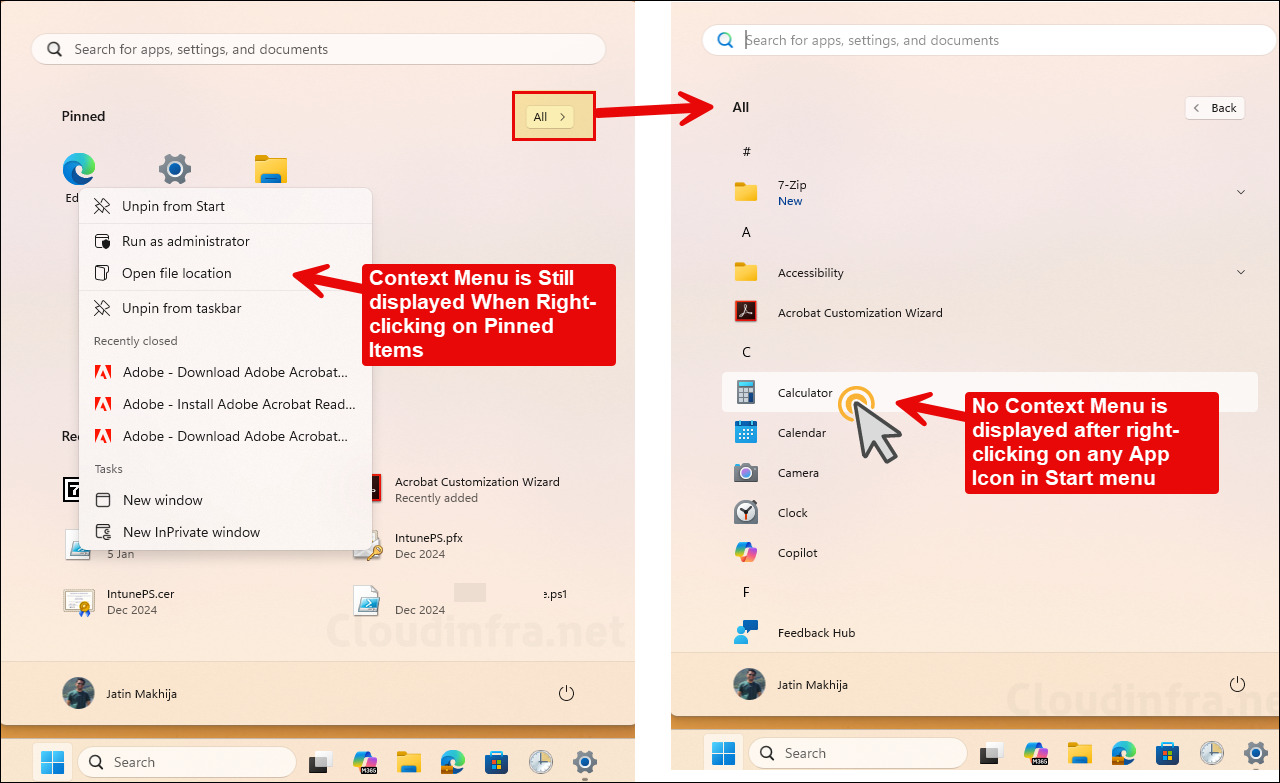
Disable Context Menu in Start Menu using Registry Editor
You can also use Windows Registry to enable or disable the right-click context menu in Start menu via Windows registry editor. Create Explorer registry key if it does not exist.
| Registry node | HKEY_LOCAL_MACHINE or HKEY_CURRENT_USER |
| Registry Path | Software\Policies\Microsoft\Windows\Explorer |
| Value | DisableContextMenusInStart |
| Type | DWORD (32-bit) |
| Enabled Value | 1 |
| Disabled Value | 0 |
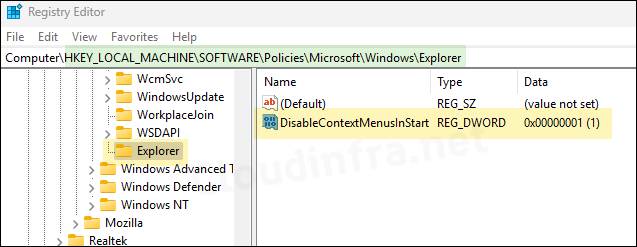
Disable Context Menu in Start Menu using Group Policy
Similar to Intune Policy, You can also use Active directory group policy for AD joined and hybrid Entra joined devices to disable the context menu in Start menu.
- Login to a Domain Controller and open Group policy management console (gpmc.msc).
- Navigate to Computer Configuration > Administrative Templates > Start Menu and Taskbar. Enable the setting Disable context menu in the Start Menu.
- Link the GPO to an OU containing Windows computers.
Disable context menu in the Start Menu is not just a device based policy, it’s also available in User context. You can enable the same policy under User configuration node, if you want to apply this to specific users only.
- User Configuration > Administrative Templates > Start Menu and Taskbar. Enable the setting Disable context menu in the Start Menu.
- Link the GPO to an OU containing Users.
Using Local Group Policy Editor
If you are not managing your devices using Active directory group policy and Intune. You can utilize local group policy editor and make this change. This change has to be made manually using local group policy editor on each device.
- Login to a device and open Local Group Policy Editor (gpedit.msc).
- Navigate to Computer Configuration > Administrative Templates > Start Menu and Taskbar. Enable the setting Disable context menu in the Start Menu.
- Restart your computer.
For User based configuration in Local group policy editor:
- User Configuration > Administrative Templates > Start Menu and Taskbar. Enable the setting Disable context menu in the Start Menu.
- Sign out and sign back on to the device to complete this change.
